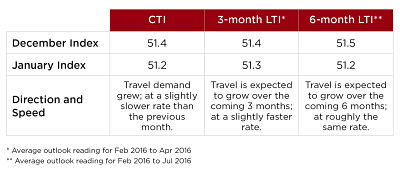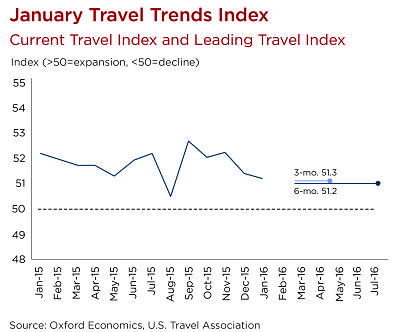Offsets Softer Business and Inbound International Segments
WASHINGTON (March 1, 2016)—Overall growth in the travel sector of the U.S. economy has leveled off but remains in positive territory, mainly thanks to a leisure travel market buoyed by strong wages and low gas prices, according to the U.S. Travel Association's monthly Travel Trends Index (TTI).
Meanwhile, the strong dollar continues its cooling effect on the inbound international travel market, and business travel will struggle to post gains in 2016 due to shaky financial markets.
The TTI consists of the Current Travel Index (CTI), which measures the number of person trips involving hotel stays and/or flights each month, and the Leading Travel Index (LTI), which measures the likely average pace and direction of business and leisure travel, both domestic and international inbound. It assigns a numeric score to every travel segment it examines—domestic and international, leisure and business—in current, 3-month predictive and 6-month predictive indicators. As with many indices similarly measuring industry performance, a score above 50 indicates growth, and a score below 50 indicates contraction.
The January CTI registered 51.2, down slightly from 51.4 in December, showing that travel demand grew in January but at a slightly slower rate than the previous month. Still, the CTI has been above 50—indicating growth—for 73 straight months.
The 3-month and 6-month predictive Leading Travel Indices (which predict future industry performance) both forecast a growth rate of just under three percent despite the aforementioned trouble spots for travel to and within the U.S.
"The softened growth in January needs to be read in context," said U.S. Travel Association Senior Vice President for Research David Huether. "Domestic leisure travel continues to perform well enough that the industry should have no trouble coping with the market and currency turbulence that has affected business and international travel. We're seeing signs all over the place that it's a win-lose economy right now—falling oil prices are great for consumers, for example, but obviously bad for the energy sector itself; however, we're seeing no evidence at all that the travel industry will miss the boat."
The U.S. Travel Association developed the TTI in partnership with Oxford Economics, and draws from multiple data sources to develop these monthly readings. In order to compile both the CTI and LTI readings, the organization's research team utilizes multiple unique, non-personally identifiable data sets, including:
- Advance search and bookings data from ADARA and nSight;
- Passenger enplanement data from Airlines for America (A4A);
- Airline bookings data from the Airlines Reporting Corporation (ARC); and
- Hotel room demand data from STR.
Learn more about the Travel Trends Index. Click here to read the full report.



